Page 555 of 1336
6) Normal Cancellation of the Cruise Control
The cruise control system will be canceled when one or more items of the following conditions are
applied;
When the brake pedal is depressed.
When the cruising speed is decreased less than 38 km/h.
When pushing the ON-OFF switch of the cruise control lever.
When ESP is activated.
When applying the parking brake while driving.
When using the clutch in order to shift (M/T only).
To cancel the cruise control function, pull the cruise switch toward you. (GSL only). 1.
2.
3.
4.
5.
6.
7.
Keep the main cruise control switch in the neutral position when not using the cruise control. And the cruise control system can be operated again in driving state.
Page 873 of 1336
Light switch
Headlamps ON
Headlamp, side-marker, tail,
license plate, fog, and
instrument cluster lamps come
on.
Tail lamp ON
Side-marker, tail, license plate,
fog, and instrument cluster
lamps come on.
Automatic light ON
Head- and tail lamps
automatically turn on or off based
upon the intensity of the sunlight
analyzed by the automatic light
sensor.Lights OFF
High beam ON
To turn on the headlamp high
beam, push the lever towards
the instrument cluster with the
headlamp low beam on.Right turn signal lamp blinks
Passing
Regardless of the position of the light
switch, when holding the lever toward the
steering wheel, the headlights are on high
beam during the hold.Front fog lamp switch
To turn on the fog lights, turn this
switch while the tail lamps or
headlamps are turned on. Left turn signal lamp blinks
Page 875 of 1336
Rear wiper switch
Type B
Type AWindshield Washer Operation
lever toward you to spray washer
fluid on the windshield and to
operate the wipers 1~3 cycles.
Pull the lever briefly (for less than 0.6
seconds): One wiping cycle with
washer spray
Pull and hold the lever for more than
0.6 seconds: Three wiping cycles
with washer spray
The spray and wiper operation will
continue until you release the lever.
TYPE B
When the switch is fully turned, washer fluid will be sprayed onto the rear window
glass and the wiper will also operate. When the switch is released, it will return to
Rear wiper is not in operation.
TYPE A
INT
Rear wiper operation
(Intermittent)
ON
Rear wiper operation
(Normal Speed)
Rear wiper operation
When the switch is fully turned, washer fluid will be sprayed onto the rear window
glass and the wiper will also operate. When the switch is released, it will return to
the Rear Wiper Operation mode and only the wiper will keep operating.
Page 940 of 1336
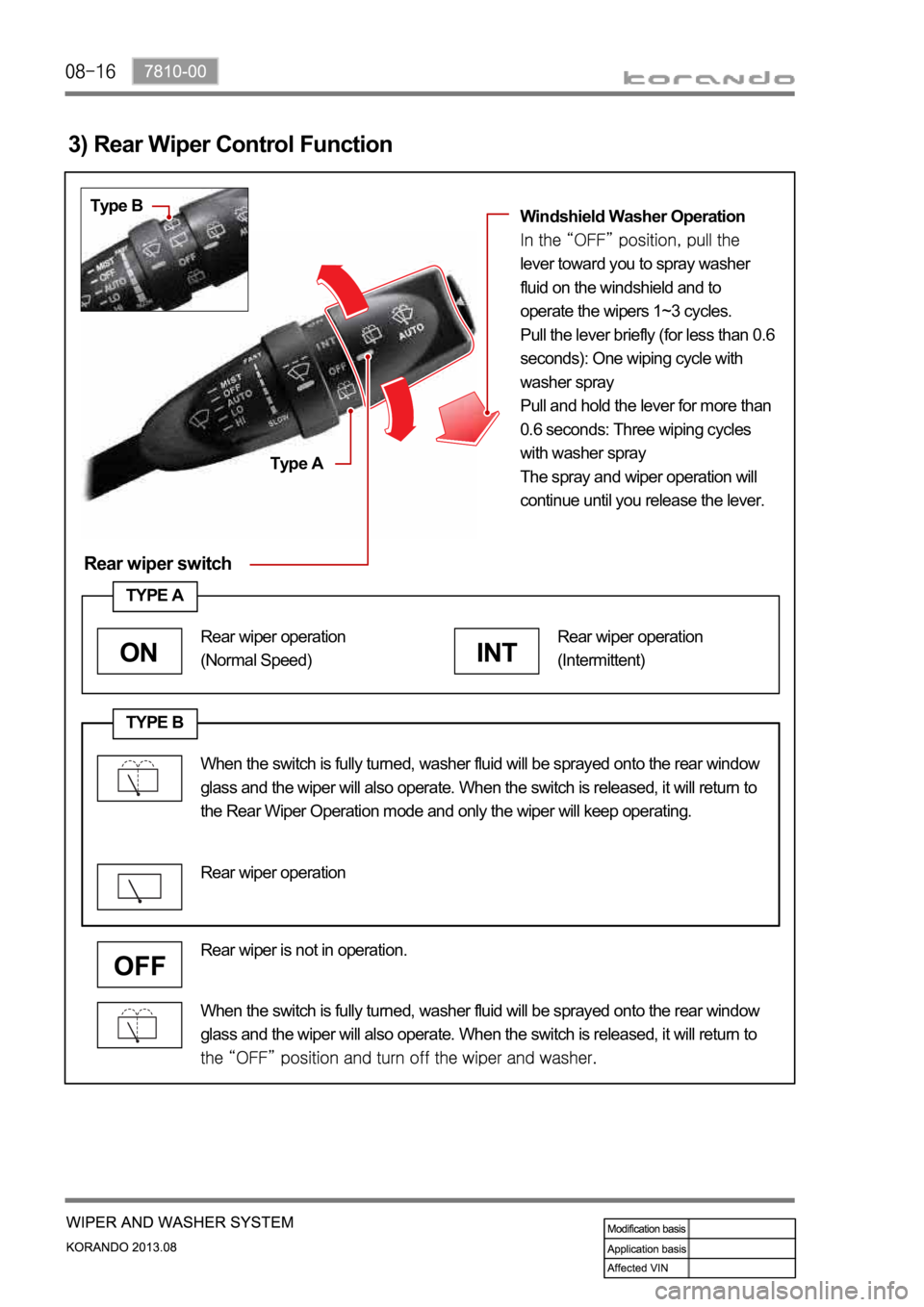
Rear wiper switch
3) Rear Wiper Control Function
Type B
Type AWindshield Washer Operation
lever toward you to spray washer
fluid on the windshield and to
operate the wipers 1~3 cycles.
Pull the lever briefly (for less than 0.6
seconds): One wiping cycle with
washer spray
Pull and hold the lever for more than
0.6 seconds: Three wiping cycles
with washer spray
The spray and wiper operation will
continue until you release the lever.
TYPE B
When the switch is fully turned, washer fluid will be sprayed onto the rear window
glass and the wiper will also operate. When the switch is released, it will return to
Rear wiper is not in operation.
TYPE A
INT
Rear wiper operation
(Intermittent)
ON
Rear wiper operation
(Normal Speed)
Rear wiper operation
When the switch is fully turned, washer fluid will be sprayed onto the rear window
glass and the wiper will also operate. When the switch is released, it will return to
the Rear Wiper Operation mode and only the wiper will keep operating.
Page 1009 of 1336
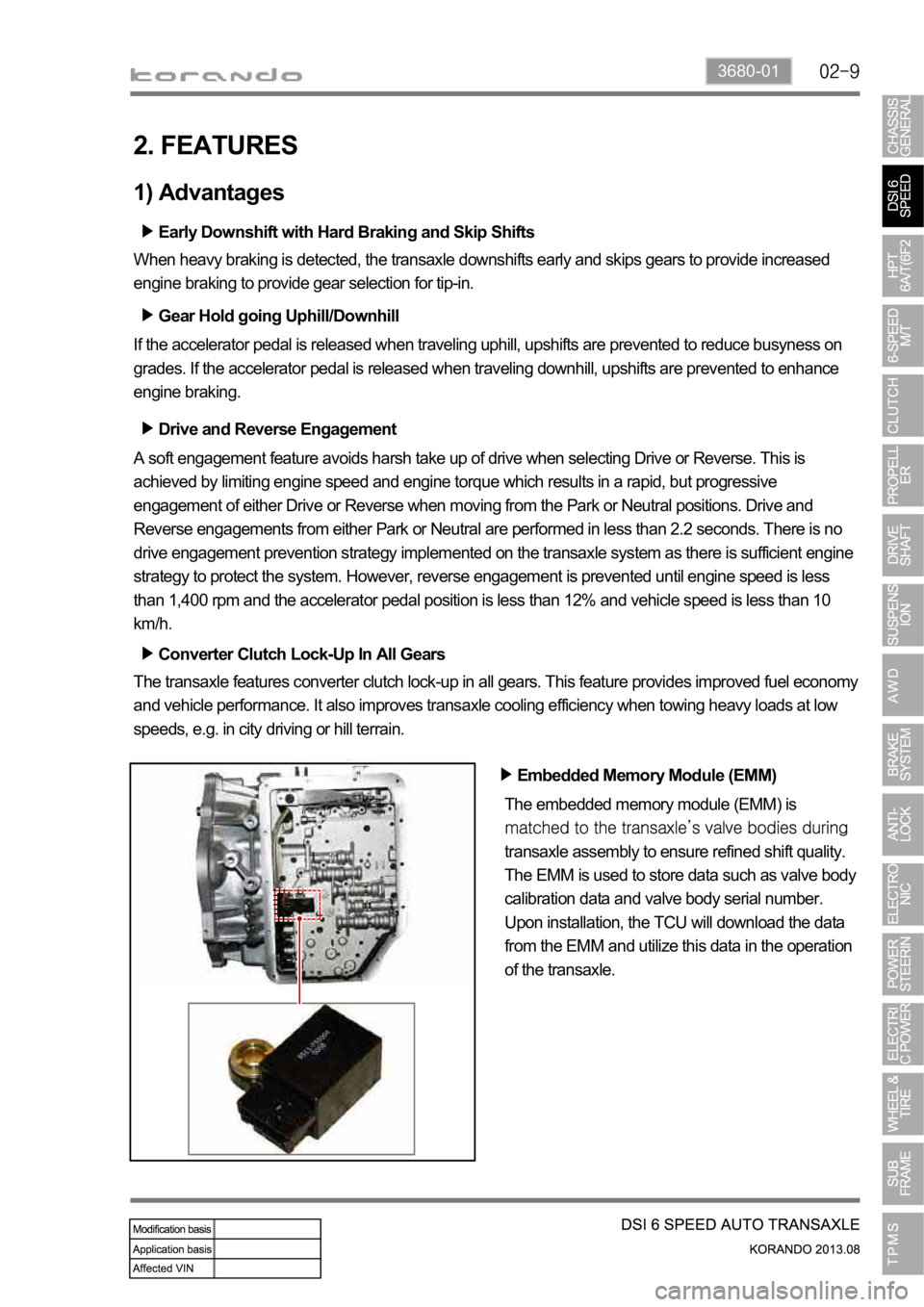
3680-01
2. FEATURES
1) Advantages
Early Downshift with Hard Braking and Skip Shifts
When heavy braking is detected, the transaxle downshifts early and skips gears to provide increased
engine braking to provide gear selection for tip-in.
Gear Hold going Uphill/Downhill
If the accelerator pedal is released when traveling uphill, upshifts are prevented to reduce busyness on
grades. If the accelerator pedal is released when traveling downhill, upshifts are prevented to enhance
engine braking.
Drive and Reverse Engagement
A soft engagement feature avoids harsh take up of drive when selecting Drive or Reverse. This is
achieved by limiting engine speed and engine torque which results in a rapid, but progressive
engagement of either Drive or Reverse when moving from the Park or Neutral positions. Drive and
Reverse engagements from either Park or Neutral are performed in less than 2.2 seconds. There is no
drive engagement prevention strategy implemented on the transaxle system as there is sufficient engine
strategy to protect the system. However, reverse engagement is prevented until engine speed is less
than 1,400 rpm and the accelerator pedal position is less than 12% and vehicle speed is less than 10
km/h.
Converter Clutch Lock-Up In All Gears
The transaxle features converter clutch lock-up in all gears. This feature provides improved fuel economy
and vehicle performance. It also improves transaxle cooling efficiency when towing heavy loads at low
speeds, e.g. in city driving or hill terrain.
Embedded Memory Module (EMM)
The embedded memory module (EMM) is
transaxle assembly to ensure refined shift quality.
The EMM is used to store data such as valve body
calibration data and valve body serial number.
Upon installation, the TCU will download the data
from the EMM and utilize this data in the operation
of the transaxle.
Page 1013 of 1336
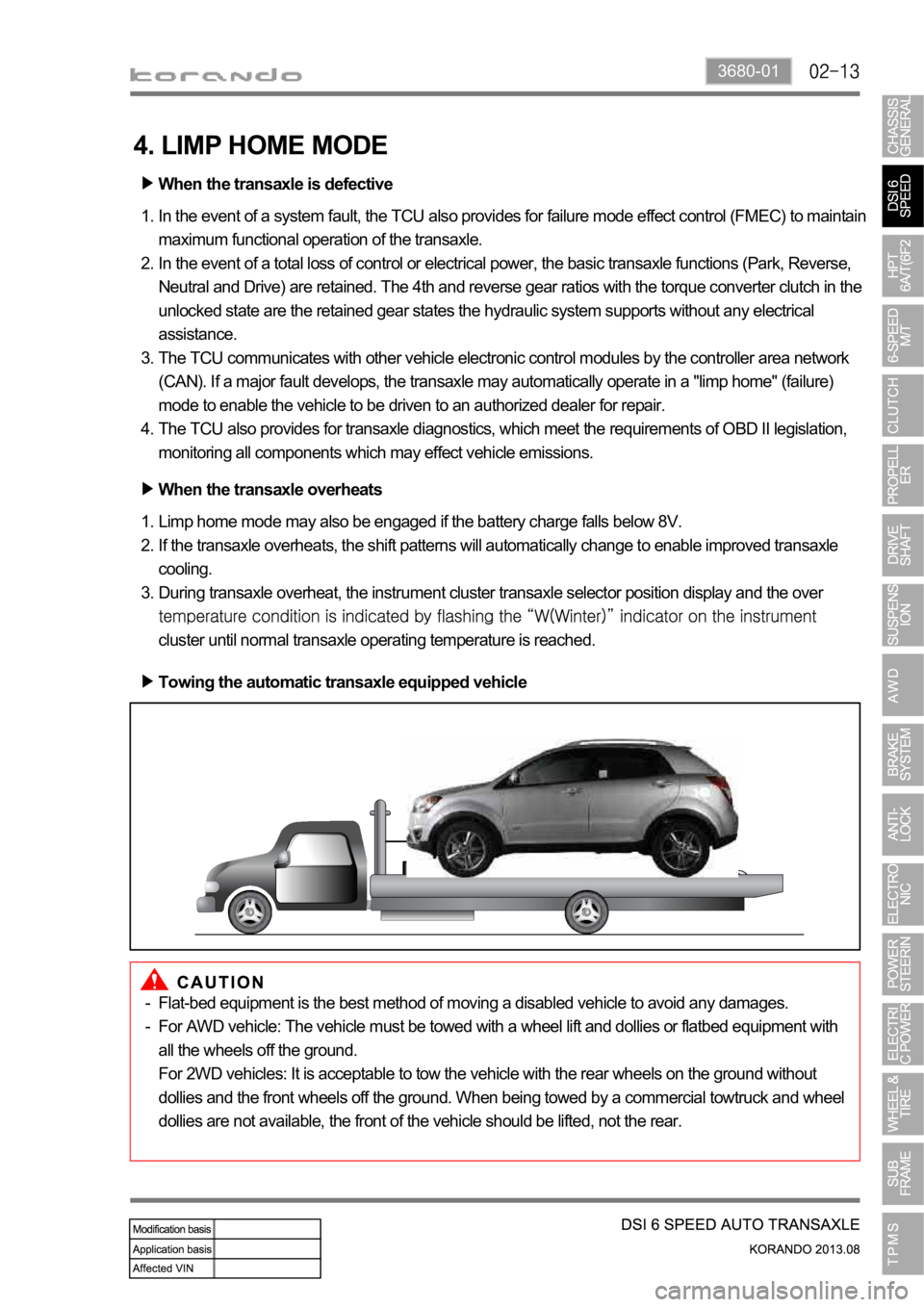
3680-01
4. LIMP HOME MODE
When the transaxle is defective
In the event of a system fault, the TCU also provides for failure mode effect control (FMEC) to maintain
maximum functional operation of the transaxle.
In the event of a total loss of control or electrical power, the basic transaxle functions (Park, Reverse,
Neutral and Drive) are retained. The 4th and reverse gear ratios with the torque converter clutch in the
unlocked state are the retained gear states the hydraulic system supports without any electrical
assistance.
The TCU communicates with other vehicle electronic control modules by the controller area network
(CAN). If a major fault develops, the transaxle may automatically operate in a "limp home" (failure)
mode to enable the vehicle to be driven to an authorized dealer for repair.
The TCU also provides for transaxle diagnostics, which meet the requirements of OBD II legislation,
monitoring all components which may effect vehicle emissions. 1.
2.
3.
4.
When the transaxle overheats
Limp home mode may also be engaged if the battery charge falls below 8V.
If the transaxle overheats, the shift patterns will automatically change to enable improved transaxle
cooling.
During transaxle overheat, the instrument cluster transaxle selector position display and the over
cluster until normal transaxle operating temperature is reached. 1.
2.
3.
Towing the automatic transaxle equipped vehicle
Flat-bed equipment is the best method of moving a disabled vehicle to avoid any damages.
For AWD vehicle: The vehicle must be towed with a wheel lift and dollies or flatbed equipment with
all the wheels off the ground.
For 2WD vehicles: It is acceptable to tow the vehicle with the rear wheels on the ground without
dollies and the front wheels off the ground. When being towed by a commercial towtruck and wheel
dollies are not available, the front of the vehicle should be lifted, not the rear. -
-
Page 1042 of 1336
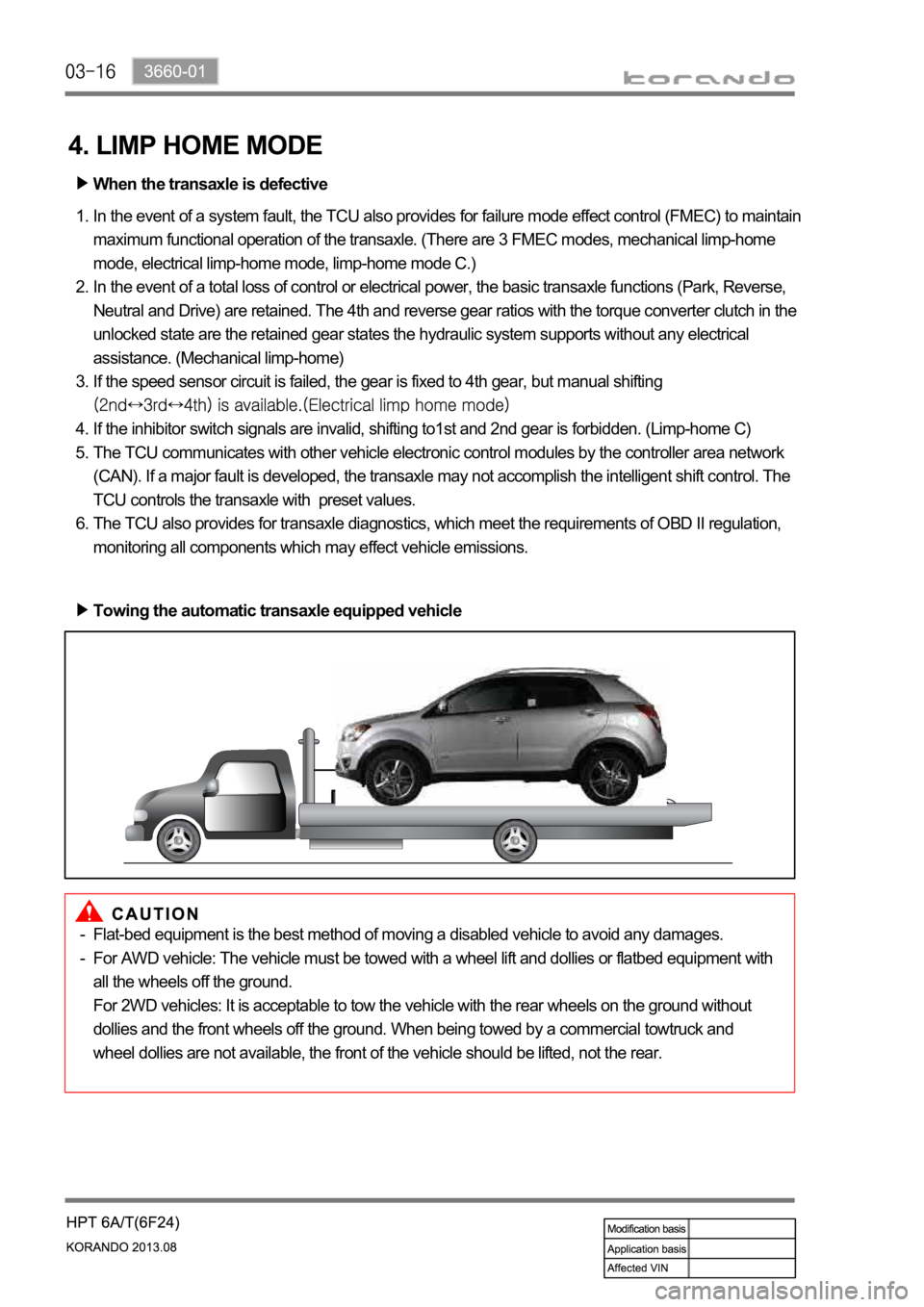
4. LIMP HOME MODE
When the transaxle is defective
In the event of a system fault, the TCU also provides for failure mode effect control (FMEC) to maintain
maximum functional operation of the transaxle. (There are 3 FMEC modes, mechanical limp-home
mode, electrical limp-home mode, limp-home mode C.)
In the event of a total loss of control or electrical power, the basic transaxle functions (Park, Reverse,
Neutral and Drive) are retained. The 4th and reverse gear ratios with the torque converter clutch in the
unlocked state are the retained gear states the hydraulic system supports without any electrical
assistance. (Mechanical limp-home)
If the speed sensor circuit is failed, the gear is fixed to 4th gear, but manual shifting
If the inhibitor switch signals are invalid, shifting to1st and 2nd gear is forbidden. (Limp-home C)
The TCU communicates with other vehicle electronic control modules by the controller area network
(CAN). If a major fault is developed, the transaxle may not accomplish the intelligent shift control. The
TCU controls the transaxle with preset values.
The TCU also provides for transaxle diagnostics, which meet the requirements of OBD II regulation,
monitoring all components which may effect vehicle emissions. 1.
2.
3.
4.
5.
6.
Towing the automatic transaxle equipped vehicle
Flat-bed equipment is the best method of moving a disabled vehicle to avoid any damages.
For AWD vehicle: The vehicle must be towed with a wheel lift and dollies or flatbed equipment with
all the wheels off the ground.
For 2WD vehicles: It is acceptable to tow the vehicle with the rear wheels on the ground without
dollies and the front wheels off the ground. When being towed by a commercial towtruck and
wheel dollies are not available, the front of the vehicle should be lifted, not the rear. -
-
Page 1128 of 1336
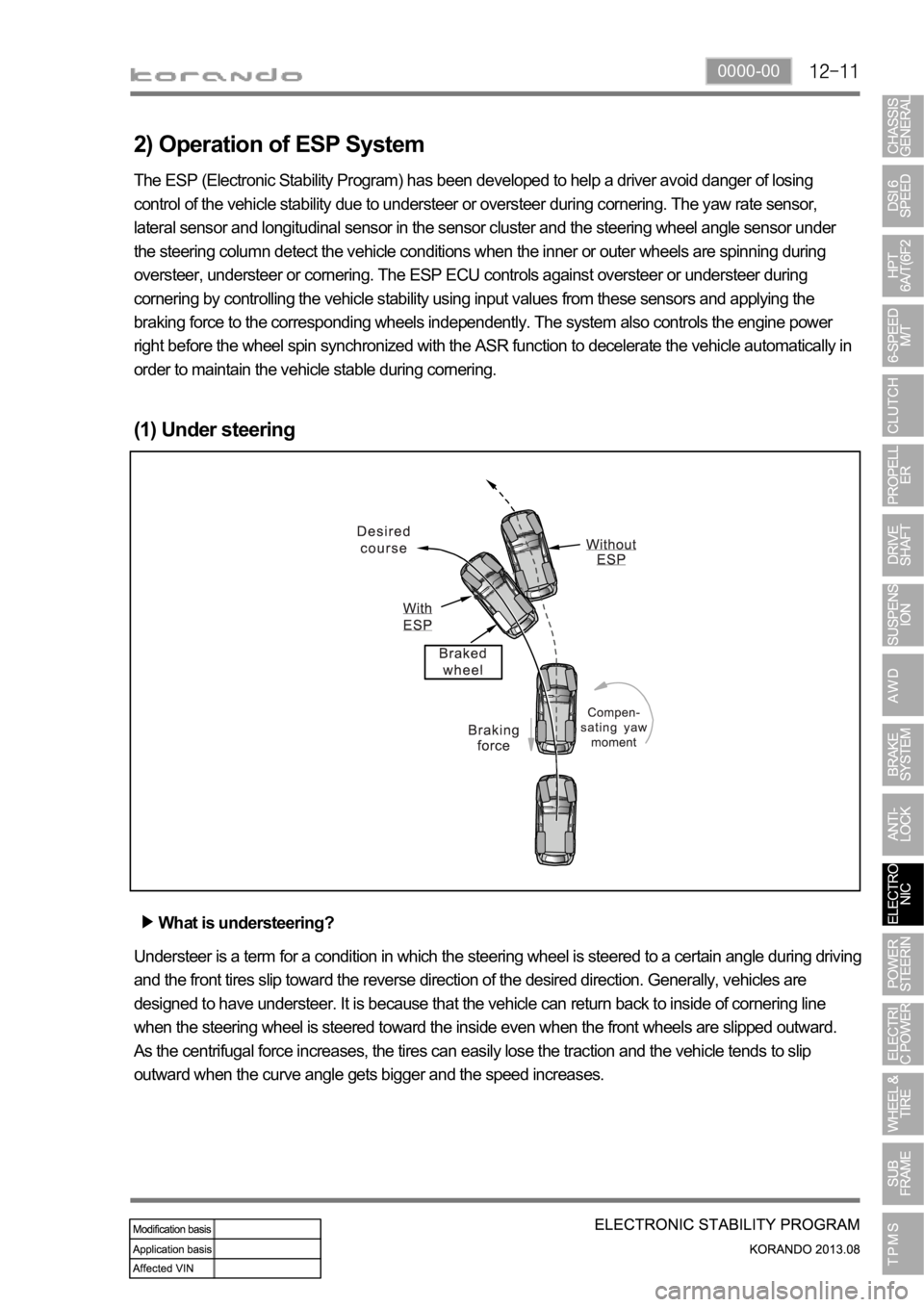
0000-00
2) Operation of ESP System
The ESP (Electronic Stability Program) has been developed to help a driver avoid danger of losing
control of the vehicle stability due to understeer or oversteer during cornering. The yaw rate sensor,
lateral sensor and longitudinal sensor in the sensor cluster and the steering wheel angle sensor under
the steering column detect the vehicle conditions when the inner or outer wheels are spinning during
oversteer, understeer or cornering. The ESP ECU controls against oversteer or understeer during
cornering by controlling the vehicle stability using input values from these sensors and applying the
braking force to the corresponding wheels independently. The system also controls the engine power
right before the wheel spin synchronized with the ASR function to decelerate the vehicle automatically in
order to maintain the vehicle stable during cornering.
(1) Under steering
What is understeering?
Understeer is a term for a condition in which the steering wheel is steered to a certain angle during driving
and the front tires slip toward the reverse direction of the desired direction. Generally, vehicles are
designed to have understeer. It is because that the vehicle can return back to inside of cornering line
when the steering wheel is steered toward the inside even when the front wheels are slipped outward.
As the centrifugal force increases, the tires can easily lose the traction and the vehicle tends to slip
outward when the curve angle gets bigger and the speed increases.